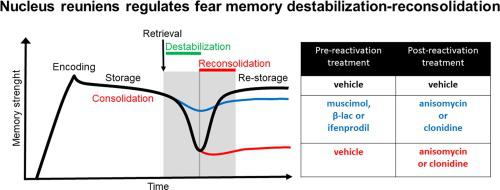Neurobiology of Learning and Memory ( IF 2.7 ) Pub Date : 2020-09-19 , DOI: 10.1016/j.nlm.2020.107313 Fernanda Troyner 1 , Leandro Jose Bertoglio 1

|
The neural circuit supporting aversive memory destabilization after retrieval includes the hippocampus, amygdala, and medial prefrontal cortex. The nucleus reuniens (NR) contributes to the functional interaction of these brain regions relevant to cognitive processing. However, the direct participation of this thalamic subregion in memory destabilization is yet to be investigated. The present study addressed this question in contextually fear-conditioned rats. Pre-reactivation infusion of the GABAA receptor agonist muscimol, the protein degradation inhibitor clasto-lactacystin β-lactone (β-lac), or the glutamate N2B-containing NMDA receptors antagonist ifenprodil into the NR prevented the post-reactivation amnestic effects of both locally infused anisomycin and systemically administered clonidine. In either case, the results suggest a significant disruption in memory destabilization. It is noteworthy that these pharmacological interventions induced no changes in expression or contextual specificity of the memory. Moreover, omitting memory reactivation precluded the muscimol, β-lac, and ifenprodil effects on destabilization and the anisomycin and clonidine effects on reconsolidation. We also quantified the Egr1/Zif268-expressing neurons to investigate the effects of muscimol-induced NR inactivation on the activity-related plasticity locally, and in other brain regions supporting fear memory destabilization-reconsolidation. Relative to controls, there were reduced values in the NR, the dorsal CA1 hippocampus, the prelimbic cortex, and the infralimbic cortex. In contrast, increases happened in the ventral CA1 hippocampus and the basolateral amygdala. These results suggest that NR has a circuit-level influence on this process. Together, present findings demonstrate how the NR can regulate contextual fear memory destabilization upon retrieval.
中文翻译:

丘脑核团聚调节检索时的恐惧记忆不稳定。
恢复后支持厌恶性记忆不稳定的神经回路包括海马体、杏仁核和内侧前额叶皮层。团聚核 (NR) 有助于这些与认知处理相关的大脑区域的功能相互作用。然而,这个丘脑亚区是否直接参与记忆不稳定还有待研究。本研究在情境恐惧条件下的大鼠中解决了这个问题。GABA A 的预激活输注受体激动剂 muscimol、蛋白质降解抑制剂 clasto-lactacystin β-内酯 (β-lac) 或含有谷氨酸 N2B 的 NMDA 受体拮抗剂艾芬地尔进入 NR 可防止局部输注茴香霉素和全身给药可乐定的再激活后遗忘效应。在任何一种情况下,结果都表明记忆不稳定的严重破坏。值得注意的是,这些药理干预并未引起记忆的表达或上下文特异性的变化。此外,省略记忆再激活排除了麝香酚、β-lac 和艾芬地尔对不稳定的影响以及茴香霉素和可乐定对再巩固的影响。我们还量化了表达 Egr1/Zif268 的神经元,以研究 muscimol 诱导的 NR 失活对局部活动相关可塑性的影响,以及支持恐惧记忆不稳定-再巩固的其他大脑区域。相对于对照,NR、背侧 CA1 海马、前边缘皮层和边缘下皮层的值降低。相比之下,腹侧 CA1 海马和基底外侧杏仁核发生了增加。这些结果表明 NR 对该过程具有电路级影响。总之,目前的研究结果证明了 NR 如何在检索时调节上下文恐惧记忆不稳定。这些结果表明 NR 对该过程具有电路级影响。总之,目前的研究结果证明了 NR 如何在检索时调节上下文恐惧记忆不稳定。这些结果表明 NR 对该过程具有电路级影响。总之,目前的研究结果证明了 NR 如何在检索时调节上下文恐惧记忆不稳定。



























 京公网安备 11010802027423号
京公网安备 11010802027423号